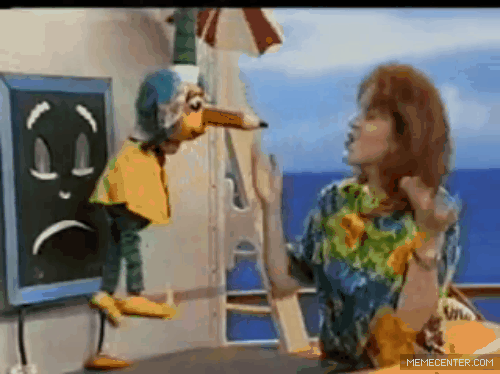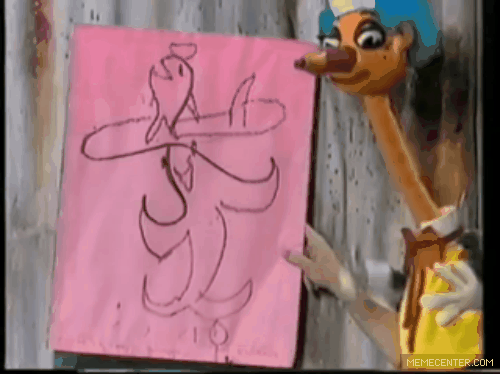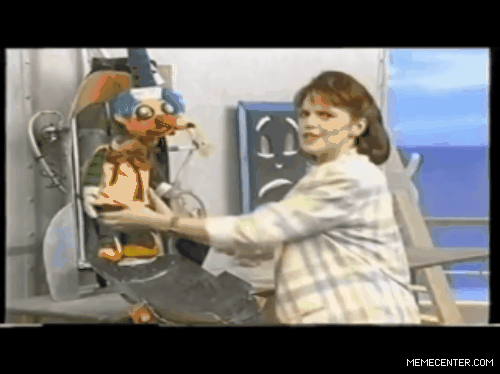Remembering Mr. Squiggle: Surrealist, Philosopher, Creative Mastermind
In terms of government-sponsored puppets, Mr. Squiggle beats Malcolm Fraser hands-down.

His name was Jolly. Mr “Jolly” Squiggle. He was a blue-haired man from the Moon with a pencil for a nose who wasn’t really meant for this world. He had one shot – one opportunity – as a last-minute fill-in for a small segment on ABC’s Children’s TV Club on 1 July 1959. No audition. What was meant to be a six-week trial went on to be, at one stage, the longest-running television program in Australia and the longest-running preschool children’s television program in the world.
After that serendipitous first appearance on television, Mr Squiggle dutifully turned your random squiggles into drawings every weekday for 40 years.
On 6 December, it’ll be four years since the death of Norman Hetherington – creator, operator and voice of Mr Squiggle. This week, though, Australia’s other puppet, Communications Minister Malcolm Turnbull, has confirmed that there will be budget cuts at Mr Squiggle’s former home, the ABC. Over five years, this $254 million worth of cuts will see the end of state-based current affairs, the closure of foreign news offices and a loss of up to 500 jobs — just in time for Christmas.
At a glance, it seems like Mr Squiggle might win out over Mr Turnbull as our favourite government-sponsored puppet — but then again, we do look back at the past through rose-coloured, nostalgia-tinted glasses. So, in the interest of even-handedness, let’s assess the relative merits of these two puppets and their contributions to the country.

First up, Mr Squiggle: He was affordable, a puppet on a shoestring. He came around not even three years after ABC’s first televised broadcast, when all wasn’t smooth squiggling. Unlike Mr Squiggle’s contemporary Scrooge McDuck, the network wasn’t exactly swimming in coin back then. John Appleton, former national director of children’s programs at ABC, once said that the budget for a single episode of a commercial children’s television show at the time was equivalent to the budget for an entire six months of Mr Squiggle.
It was very much a family affair. While Norman Hetherington operated and voiced the puppets, his wife Peggy wrote the scripts. In the show’s final years, their daughter Rebecca starred as Mr Squiggle’s assistant. In what may or may not be a coincidence, even the theme song was composed by a husband-and-wife duo, Geoff and Jenny Ayling, the same people responsible for the “Good on ya mum, Tip Top’s the one” jingle.
Mr Squiggle was clever, too. Many of his most memorable characteristics were just creative workarounds driven by necessity. His tall hat, for example, was a solution to an age-old problem unique to Sicilian-style marionettes. They’re traditionally operated with a rod that sticks out the top of the puppet’s head, which Hetherington sneakily concealed with the hat. When Mr Squiggle was on screen, you never see the tip of the hat, and the magic is maintained.
Even Mr Squiggle’s telltale tendency to draw his pictures upside down was a workaround too. From where Hetherington was positioned, everything looked upside down to begin with.

It’s silly to focus too much on Hetherington though, especially when considering Mr Squiggle’s own accomplishments as an artist. Over the course of his prolific, 40-year-long practice, he completed more than 10,000 works across a range of different media including felt pen, crayon, oil chalk and chalk, all of them featuring a decidedly Surrealist sensibility.
What made Mr Squiggle stand out among other Surrealists, though, was his use of economy and restraint, his ability to conjure up richly and detailed imagery with a few, swiftly executed bare lines. Describing one of the works on canvas he produced during his later period, Mr Squiggle said, “The fish is balancing on a surf ski and the surf ski is balancing on a seal’s nose and the seal is balancing on a ping pong ball – he’s using it as a roller skate – and there’s a tomato balanced on top of the fish’s nose.”
That he could say so much with so little speaks to a mastery of both medium and concept.

But perhaps his greatest talent was his personality. He was kind and gentle and patient, different to the other puppets on Australian TV. He was weird too, like a doddery old eccentric professor: softly spoken and absent-minded, excitable to the point of stammering, scattered and easily distracted. At puppet school he would’ve been the puppet that Agro would’ve teased for being a “freak”.
For decades he’d make that same long commute from 93 Crater Crescent to ABC’s Studio 23. It was an uncomfortable ride in an uncooperative rocket that didn’t even have room for his nose, but he did it.

Once he’d arrived, he’d spend the entire time turning squiggles sent in by kids – real kids, like you and me – into something magical. All while in a rush, all while being hectored to “Hurry up!” by a grumpy Blackboard. The only thing he needed in return was to be able to hold someone’s hand – a need he saw as a strength, not a vulnerability. “With you holding my hand,” he once said to an assistant, “I’m sure of everything.”
Meanwhile, his squiggles were subtly shaping our minds. Psychologists have used drawing tests similar to squiggles to measure all sorts of things for years. One such test, the Morrisby Profile, which is currently used for career guidance across Australia today, has what is in effect a Mr Squiggle test wherein people are asked to turn random squiggles into drawings. An occupational psychologist who works for the company that administers the profile explained that it has nothing to do with artistic ability. “The drawing test (Speed Test 4b),” he said, “is actually a test of ideational fluency, the fluency with which we can generate ideas under pressure. It provides information about initiative, decisiveness and external confidence.”
So by learning to squiggle, we inadvertently learned how to be smart, strong and self-assured. At the same time, Mr Squiggle taught us that it’s also possible to be smart, strong and self-assured even if, from time to time, we need to hold someone else’s hand.
Oh, and then there’s Mr Turnbull. Costs somewhere in the vicinity of $336,599 a year to operate. Unlike other puppets, is trying to introduce mandatory metadata collection. Appears wooden and displays unconvincing joint articulation. 0/10.
–
Toby Fehily is assistant editor at Art Guide Australia and a freelance writer. His work has appeared in Smith Journal, ABC Radio National and VICE. He doesn’t really tweet at @tobyfehily